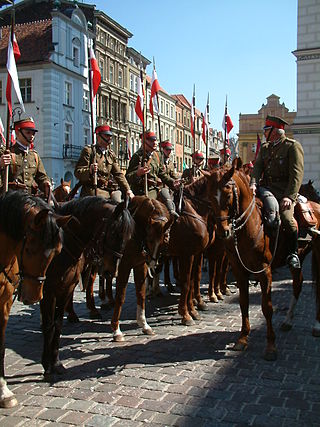
The Polish cavalry can trace its origins back to the days of medieval cavalry knights. Poland is mostly a country of flatlands and fields and mounted forces operate well in this environment. The knights and heavy cavalry gradually evolved into many different types of specialised mounted military formations, some of which heavily influenced western warfare and military science. This article details the evolution of Polish cavalry tactics, traditions and arms from the times of mounted knights and heavy winged hussars, through the times of light uhlans to mounted infantry equipped with ranged and mêlée weapons.
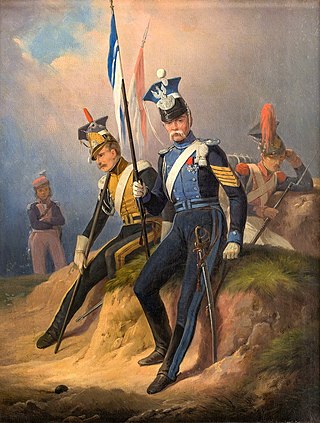
Uhlan is a type of light cavalry, primarily armed with a lance. The uhlans started as Lithuanian irregular cavalry, that were later also adopted by other countries during the 18th century, including Poland, France, Russia, Prussia, Saxony, and Austria-Hungary. The term "lancer" was often used interchangeably with "uhlan"; the lancer regiments later formed for the British Army were directly inspired by the uhlans of other armies.

The Volhynian Cavalry Brigade was a Polish cavalry brigade, which saw action against the invading Germans during the Invasion of Poland, a part of World War II. Raised from recruits in the area of Wołyń, the division was posted to the Łódź Army. During several desperate counter-attacks, the brigade suffered heavy casualties near Łódź. It was commanded by Colonel Julian Filipowicz. Most notably, the unit took part in one of the first battles of the German invasion of Poland, the battle of Mokra.
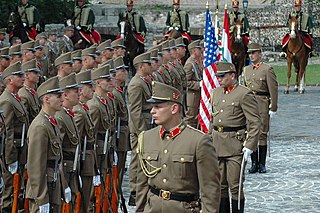
A guard of honour, honor guard or ceremonial guard, is a group of people, typically drawn from the military, appointed to perform ceremonial duties – for example, to receive or guard a head of state or other dignitaries, the fallen in war, or to attend at state ceremonials, especially funerals. In military weddings, especially those of commissioned officers, a guard, composed usually of service members of the same branch, form the sabre arch. In principle, any military unit could act as a guard of honour. In some countries, certain units are specially assigned to undertake guard of honour postings or other public duties. Republican guards, royal guards and foot guards frequently have ceremonial duties assigned to them.

The Polish People's Army constituted the second formation of the Polish Armed Forces in the East in 1943–1945, and in 1945–1989 the armed forces of the Polish communist state, ruled by the Polish Workers' Party and then the Polish United Workers' Party. The communist-led Polish armed forces, allowed and facilitated by Joseph Stalin, were the result of efforts made in the early 1940s in the Soviet Union by Wanda Wasilewska and Zygmunt Berling.

The Air Force of the Polish Army, unofficially known as the People's Polish Air Force was the name of the Soviet-controlled Polish Air Force in the USSR between 1943 and 1947 created alongside the Polish People's Army, a subordinate to the Red Army. It was the primary Polish air force formation within the Polish Armed Forces in the East during World War II.

National Independence Day is a national day in Poland celebrated on 11 November to commemorate the anniversary of the restoration of Poland's sovereignty as the Second Polish Republic in 1918 from the German, Austro-Hungarian and Russian Empires. Following the partitions in the late 18th century, Poland ceased to exist for 123 years until the end of World War I, when the destruction of the neighbouring powers allowed the country to reemerge. It is a non-working day and a flag flying day in Poland.

Modlin Army was one of the Polish armies that were part of the Polish defense against the German Invasion of Poland. After heavy casualties in the battle of Mława, the Army was forced to abandon its positions near Warsaw around September 10; eventually it took part in the battle of Tomaszów Mazowiecki and surrendered afterwards.
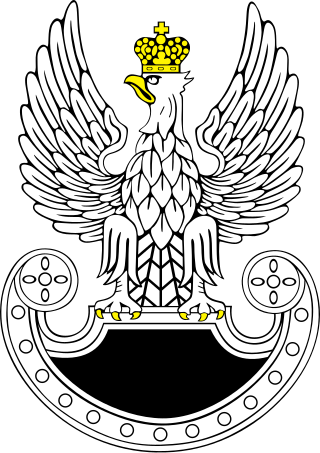
The Special Troops Command is the special forces command of the Polish Armed Forces. The command was formed in 2007 and is the fourth military branch of the SZ RP.

15th Poznań Uhlan Regiment – unit of Polish cavalry, part of Greater Polands Army, Polish Army of Second Republic and Polish Armed Forces in the West during World War II.

Szabla wz. 34 was the last service sword issued to the Polish cavalry and other mounted units of the Polish Army. One of the finest weapons in a long list of Polish sabres reaching back to the early 16th century, although its introduction occurred as swords finally became obsolete as military weapons, it was successfully used in combat during the 1939 Invasion of Poland and remains in service as a ceremonial weapon.

Armed Forces Day, known also as the Feast of the Polish Armed Forces, is a national holiday celebrated annually on 15 August in Poland, commemorating the anniversary of the 1920 victory over Soviet Russia at the Battle of Warsaw during the Polish–Soviet War. Armed Forces Day is held in conjunction with the Day of the Assumption of the Virgin Mary, itself a separate public holiday. The event is marked by military parades, equipment reviews, showcases and remembrances by all branches of the Polish Armed Forces across the country. One of the most prominent events of the day is in the capital Warsaw, which hosts a large military parade through the city's center. Originally celebrated during the Second Republic, the holiday was barred by authorities during the communist era beginning in 1947, only to be revived again in 1992.

The Representative Regiment of the Polish Armed Forces is an Honor Guard unit of the Polish Armed Forces, of regimental size. It performs public duties for the armed forces and the President of Poland throughout the Warsaw Capital Garrison region and acts as the main drill and ceremony unit for the military. It performs during the annual Armed Forces Day parade on Ujazdów Avenue, during state arrival ceremonies at the Presidential Palace and alongside other honor units at the National Independence Day ceremony. The regiment has been described by President Andrzej Duda as one of "the best-drilled and organised formations in the world".

The Representative Band of the Polish Armed Forces is a military music unit that provides musical accompaniment for official state ceremonies in the Republic of Poland. The musicians of the band are required to play ceremonial music for visiting heads of state as well as perform during national events. Since the establishment of the Third Republic in 1989, the band has become chief among its other counterparts, including the Warsaw Capital Garrison Band and the Representative Band of the Polish Land Forces. It is currently attached to the 1st Guards Battalion, Representative Honor Guard Regiment.

The Presentation of Colours is a military ceremony that marks an anniversary or significant event in the history of a particular regiment or similar military unit. This involves the presentation of a new version of the regimental colour to a regiment or equivalent formation in their respective armed forces service branch. This is a traditional ceremony that was pioneered by the British Armed Forces, and is today used in most Commonwealth countries.

The Warsaw Garrison Command (WGC) is a stand-alone military unit subordinate to the Ministry of National Defence charged with providing operational, logistic and security support for the Ministry and central command units of the Polish Armed Forces, based in Warsaw military district. Command's units also perform ceremonial duties during state visits, parades, other events and daily provide honour guarding of the Presidential Palace and the Tomb of Unknown Soldier.
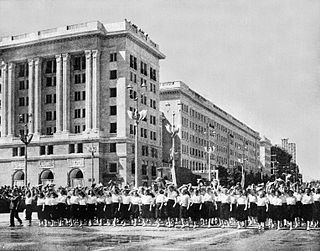
National Day of the Rebirth of Poland is a former national holiday in the former People's Republic of Poland and a fraternal anniversary in the Polish United Workers Party and all Polish communists, celebrated from 1944 to 1989. It commemorates the signing of the PKWN Manifesto on 22 July 1944.
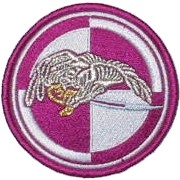
The 25th Air Cavalry Brigade is a brigade of the Polish Armed Forces, headquartered in Tomaszów Mazowiecki. The brigade serves as air assault troops, enabling the formation to be transported to battle by helicopters in large numbers.

Polish Armed Forces were the armed forces of the Second Polish Republic from 1919 until the demise of independent Poland at the onset of Second World War in September 1939.

Julian Edwin Arnoldt-Russocki was a Polish lieutenant colonel of the Polish Armed Forces who commanded the 16th Greater Poland Uhlan Regiment during the early battles of the Invasion of Poland and was the main commander at the Battle of Bukowiec before being captured two days later.

























